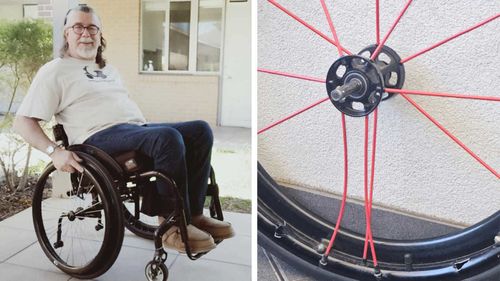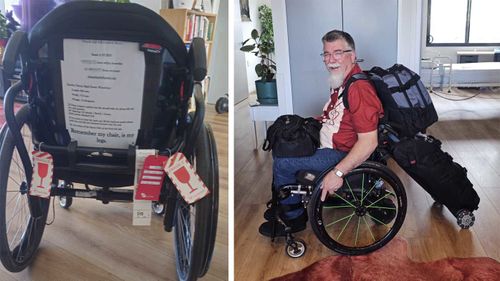When Sydney man Stuart Hurst – who is a paraplegic – prepares to go on a flight, he makes sure a laminated sign is displayed prominently on the back of his wheelchair.
Along with his contact details and the dimensions of his $35,000 chair, is a personal message to baggage handlers: “Remember, this chair is my legs.”
It was a plea that seemingly went ignored in December last year, when Hurst flew back to Sydney after a trip to Melbourne.

The 62-year-old went to disembark from the Virgin flight, only to find three spokes of his chair’s wheel were bent and there was a hole in the wheel’s rim.
“You’ve got no idea of the stress levels,” Hurst said, while explaining the logistics of trying to get back to his Rockdale home that day.
Just a month earlier, while flying back from Auckland, Air New Zealand accidentally left his wheelchair behind.
Flying with Latam Airlines to Auckland in December 2023, Hurst’s wheelchair was damaged so severely that the repairer suspected it had been dropped from the cargo hold onto the tarmac.
“The axle was bent, the wheel was bent, and I was hotel-bound for the whole time I was in Auckland,” Hurst said.
“It meant I couldn’t go and meet my grandson, who had just been born and was in hospital.”
All up, Hurst says he has personally experienced his wheelchair getting lost or damaged by airlines five times in the last three years.
“It’s not sympathy we’re after, it’s just empathy. I just want them to treat our chairs with the understanding that they are our lifelines – it’s how I get around,” Hurst said.

Hurst said there was also little consistency shown by the airlines when things went wrong.
Virgin covered the cost of repairing his wheelchair and offered him a travel voucher as compensation, while Latam paid only for the chair to be fixed.
Air New Zealand, meanwhile, was brilliant in their response, and bent over backwards to make sure he got home safely in a taxi, with his wheelchair delivered to his door the next day, Hurst said.
But no matter how great the airline’s actions after the event, the fact remained that having a wheelchair damaged or lost was a devastating and all too common experience for plane passengers with a disability, he added.
Hurst has always been an avid traveller, both before and after the accident where he lost the use of his legs.
It was during a trip to Nepal in 2018 when he was paralysed in an almost fatal crash.
Hurst was airlifted to Bangkok after the catastrophic accident, where he spent a month in hospital undergoing multiple brain surgeries before being flown back to Sydney.
“I was brain dead,” Hurst said.
“My brothers were called into Royal North Shore Hospital and I was on the bed with tubes hanging out everywhere.
“Doctors said that it was as good as I’d get, and I’d need 24-hour-a-day, seven-day-a-week care.
“Don’t ask me how, or why, but I got through it. I was in hospital for 23 months. I’ve just been so lucky.”
Hurst’s appetite for travel has led him to start the website The Travelling Para and he said he hoped to use his platform to help advocate for the change that passengers with a disability desperately needed.
In response to Hurst’s petition, Air New Zealand general manager customer, Alisha Armstrong, said: “At Air New Zealand, we understand how essential wheelchairs and other types of mobility equipment are to our customers, and we take our responsibility to handle them with care extremely seriously.
“We have been in touch with Mr Hurst directly and thank him for bringing attention to this important issue.
“We recognise there is always more we can do to improve the travel experience for customers with accessibility needs.”
A Virgin Australia spokesperson said the airline was committed to ensuring that travelling with Virgin Australia was safe, accessible and dignified for all our guests.
“We recognise there is work to be done involving stakeholders from across the aviation ecosystem, including airlines and airports, to improve the travel experience for guests with a disability.
“We are actively engaged with government and industry stakeholders on accessibility matters and we will continue to work closely as the new Aviation Standards are developed as an output of the Aviation White Paper.”
